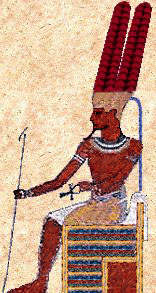
Amun-Re; Ammon; Amon; Amun
Amun, reconstructed Egyptian Yamanu , was the name of a deity in Egyptian mythology who in the form of Amun-Ra became the focus of the most complex system of theology in Ancient Egypt. Whilst remaining hypostatic deities, Amun represented the essential and hidden, whilst in Ra he represented revealed divinity. As the creator deity "par excellence", he was the champion of the poor and central to personal piety. Amun was self created, without mother and father, and during the New Kingdom he became the greatest expression of transcendental deity in Egyptian theology. He was not considered to be immanent within creation nor was creation seen as as an extension of himself. Amun-Re, likewise with the Hebrew creator deity, did not physically engender the universe. His position as King of Gods developed to the point of virtual monotheism were other Gods became manifestations of him. With Osiris Amun-Re is the most widely recorded of the Egyptian Gods.
Amun is known from an early date from references in the Pyramid texts where he is shown as a primeval deity who symbolised creative force. Initially, a religious concept that was identified as the air in the Ancient Egyptian myths of creation included Amunet and Amun as dual aspects. These religious beliefs varied by region. In Thebes, Amun came to be associated with the breath of life, one of the deities who created part of the ba. In the areas where Amun was worshiped, by the First Intermediate Period, this association had led to his being thought of as a creator, titled father of the gods. These changes in beliefs preceded the Ogdoad, although they also were part of it.
As he became more significant, he was paired with a goddess (his counterpart, Amunet, being the female aspect of the early concept of air, rather than a wife), and since he was becoming identified as a creator, it was considered more appropriate to designate him as the spouse of the divine mother from whom the cosmos emerged to enhance his status. By the time that Amun rose to this recognition, the divine mother was Mut. Amun became depicted in human form, seated on a throne, wearing on his head a plain, deep circlet from which rise two straight parallel plumes. The plumes may have been symbolic of the tail feathers of a bird, a reference to his earlier status as a wind deity.
Having become more important than Montu, the local war deity of Thebes, Montu's authority then diminished and he was said to be the son of Amun. As Mut then was said to be infertile, it was believed that she, and thus Amun, had adopted Montu instead of giving birth to him. This changed later when Montu was replaced by Khonsu, the lunar deity as her adopted son.

Rise of Cult after Expulsion of Hyksos
When the army of the founder of the Eighteenth dynasty expelled the Hyksos rulers from Egypt, the victor's city of origin, Thebes, became the most important city in Egypt, the capital of a new dynasty. The local patron deity of Thebes, Amun, therefore became nationally important. The pharaohs of that new dynasty attributed all their successful enterprises to Amun and they lavished much of their wealth and captured spoil on the construction of temples dedicated to Amun. The cultural advances achieved by the pharaohs of this dynasty brought Egypt into a cultural renaissance, restoring trade and advancing architectural design to a level that would not be achieved by any other culture for a thousand years.
As the Egyptians considered themselves oppressed during the period of the Hyksos rule, the victory accomplished by pharaohs worshiping Amun was seen as a champion of the less fortunate. Consequently, Amun was viewed as upholding the rights of justice for the poor. By aiding those who traveled in his name, he became the Protector of the road. Since he upheld Ma'at (truth, justice and goodness) - those who prayed to Amun were required, first, to demonstrate that they were worthy by confessing their sins.
Much later, because of the evidence of the adoration given to Amun in many regions during the height of his cult, Greek travelers to Egypt would report that Amun - who they determined to be the ruler of the Egyptian pantheon - was similar to the leader of the Classical Greek pantheon, Zeus, and therefore they became identified by the Greeks as the same deity. Likewise, Amun's consort Mut became associated by these Greeks with Zeus's consort in the Classical pantheon, Hera.
In the Greek period (and somewhat earlier, in order to ascribe many attributes to Amun-Re, he was sometimes depicted in bronze with the bearded head of a man, the body of a beetle with the wings of a hawk, the legs of a man and the toes and claws of a lion. He was further provided with four hands and arms and four wings.